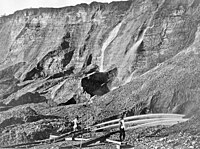
Photo from wikipedia
Abstract Sharp physio-chemical gradients occur in Archean gold systems, yet they are often poorly defined. These physio-chemical gradients can provide windows into fluids that deposit high-grade gold mineralization. Recognizing different… Click to show full abstract
Abstract Sharp physio-chemical gradients occur in Archean gold systems, yet they are often poorly defined. These physio-chemical gradients can provide windows into fluids that deposit high-grade gold mineralization. Recognizing different alteration styles and fluid-types in mineral systems helps define processes that led to the deposition of high-grade gold. Here we report on the architecture and chemical gradients across the komatiite-hosted Wattle Dam gold deposit in the eastern Yilgarn Craton, Western Australia, which is one of Australia’s highest grade-gold deposits. The deposit notably contains millimeter- to centimeter-thick gold-only veins with an absence of quartz. Whole rock geochemistry shows that high-grade gold veins are hosted in komatiite flow-margins facies with olivine orthocumulate komatiites in the footwall, interbedded graphitic shale close to the lode and komatiite basalt in the hangingwall. The komatiite flow-margin facies that hosts high-grade gold veins have been pervasively altered by stage 1 biotite-actinolite. Stage 2 gold veins cross-cut the biotite-actinolite altered komatiite and these veins contain thin (
Journal Title: Ore Geology Reviews
Year Published: 2020
Link to full text (if available)
Share on Social Media: Sign Up to like & get
recommendations!